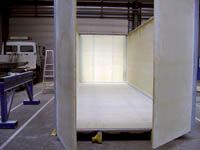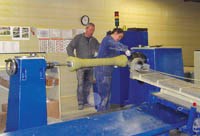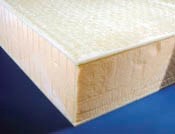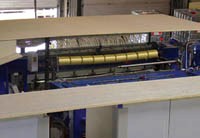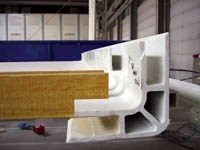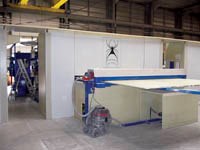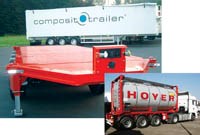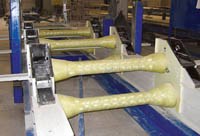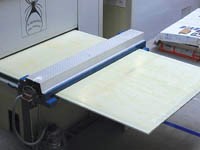Tough 3-D Panel Process Combines Technologies
Automated process produces impact-resistant panels for transportation and other applications.
When composite freight trailer manufacturer Composittrailer (Lokeren, Belgium) tried to locate a supplier of strong, impact-resistant structural sidewall and floor panels for its heavy-duty, over-the-road bulk-hauling trailers, it found no manufacturer that could meet its performance specifications. Admittedly, those specifications were stringent, says Jan Vandenberghe, sales manager for Composittrailer. "When you're hauling a load of apples or potatoes," he explains, "vibration tends to pack the load tighter and tighter and put surprisingly high loads on a freight trailer's side panels." The company, a spinoff of truck manufacturer Group Stevens N.V., whose trailer product was previously profiled in a CT "Engineering Insights" article (see CT February 2003, p. 36), decided to design and build its own panels. Using finite element analysis (FEA), panels were designed to withstand Composittrailer's specified load of 1,200N/270 lb-force applied at the center of a sidewall, without deflecting more than 4 mm/0.16 inch.
The result was a sandwich panel with inner and outer laminate skins separated by a structural foam core. While the first side panels on Composittrailer truck prototypes were made with vacuum-assisted resin transfer molding (VARTM), the company wanted a faster, automated process with more consistent output, to produce a tougher product. The company has since patented an automated and versatile panel manufacturing method trademarked Acrosoma, which combines several previously unrelated processes, including pultrusion, sandwich laminating and carpet weaving. The Acrosoma process was brought online in mid-2003. During a recent European visit, CT got a chance to visit Composittrailer's facility and observe manufacturing first hand.
Incorporating the Best From Multiple Technologies
The heart of Acrosoma's continuous panel molding technology is a custom manufacturing machine installed at Composittrailer's Lokeren facility, a 6,000m2 (63,000 ft2) building just south of the city of Ghent. The combination panel laminator/pultrusion machine/stitching device was developed and built in partnership with a proprietary equipment manufacturer. Basically a very wide, thin pultrusion device, the machine incorporates material handling features and z-stitching capabilities together with the compaction/consolidation features of a panel laminator.
The process starts when technicians load a closed-cell polyurethane or polyvinylchloride (PVC) foam plate, 30-mm/1.2-inch thick and 2.65m/8.6 ft wide, into the machine's upstream end. Klegecell, a stiff PVC foam supplied by DIAB (Laholm, Sweden) is typically used for Composittrailer truck panels, but any type or density of foam can be substituted says Composittrailer's customer service manager Bart van Eeckhout.
When put into motion, the machine pulls the foam plate with hydraulic grippers while simultaneously pulling continuous E-glass fiber mat from tensioned material rollers mounted above and below the foam delivery mechanism. The machine places one ply of mat over and under the foam to form the panel skins. Any type of skin material, including woven fiberglass, aramid or carbon fabrics or even metal meshes, can be substituted to suit particular applications. With a change in tooling, the machine can accommodate foam core thickness up to 120 mm/4.8 inches.
After several inches of travel, with the dry materials collimated within the machine bed, the panel layup passes through a modified carpet manufacturing device, essentially a stitching bar fitted with a row of several hundred needles, which are threaded with individual rovings of aramid fiber. The needles, spaced 1 cm/0.38 inch apart, punch through the panel thickness, pulling the aramid down through the foam and lower skin. As the panel continues to move forward, the process is repeated with a new row of holes. The technique, known as "tufting," is common in carpet manufacturing and results in a series of rows of through-stitched aramid in the z-direction, spanning the entire panel width and thickness, with parallel aramid rovings running the length of the upper skin, from hole to hole. Depending on machine speed, z-stitch spacing can be varied slightly, but is typically 1 cm/0.38 inch.
A few inches downstream of the stitching bar, the stitched panel layup enters a pultrusion die, where heat is applied and vinyl ester resin is injected, saturating the upper and lower skins. Because the foam is a closed-cell type, resin does not saturate the foam itself but flows only into the punched holes, essentially potting the aramid and tying the two skins together. As with all pultrusion processes, cure occurs within several feet of the resin injection point. By continuously feeding in core panels, which are adhesively bonded together, very long, continuous lengths of panel can be run out into the facility space. Panels are cut to length with a cutoff saw.
The panel production rate is about 25m/80 ft per hour, and final panel density, using standard Klegecell, is approximately 10 kg/m2 (2.05 lb/ft2). "Panels have high bending stiffness and excellent damage and buckling resistance," notes van Eeckhout. Risk of delamination is low, because the z-directional fibers penetrate both the core and the skins. The process also offers tailorability, because foam plates of higher density can be inserted in specific areas to improve performance, he says. Build-ups for fasteners can be added manually during panel layup.
Part of the Whole Package
Panels become part of a Composittrailer chassis in the adjoining areas within the Lokeren manufacturing facility. Each ladder-like trailer chassis is made from two pultruded, lengthwise frame rails connected by filament-wound cylindrical shafts. The beefy frame rails are box beams with a single, horizontal internal shear web, manufactured offsite by Top
Glass (Pioltello, Italy), using a combination of stitched unidirectional and woven E-glass fabrics combined with vinyl ester. Each beam's top surface incorporates integral channels that enable the Acrosoma side and floor panels to slot into place.
The connecting shafts, called "trumpets" because their diameters progressively expand at each end to form cone shapes, are wound in-house on a four-axis, CNC filament winding machine supplied by Material SA (Brussels, Belgium). E-glass roving wet out in a vinyl ester or epoxy bath is wound both helically and in the hoop direction around a polystyrene foam mandrel with the cone shapes on either end. For European bulk trailers, finished trumpets weigh 7.6 kg/16.7 lb. (Weight is reduced on U.S. trailers, which have different specifications for a longer, narrower chassis design. See sidebar, p. 37). Bonded and bolted to the frame rails, their unusual shape helps control torsional and shear loads, explains Vandenberghe. The number of trumpets per chassis depends on anticipated loads but, typically, 10 are used.
Assembled chasses are completed with pultruded suspension hangers, which are bonded and bolted to the main frame rails. The hangers provide the attachment points for the trailer's axles and wheels.
A fully equipped static and dynamic testing facility has been installed at the factory, where chassis members and Acrosoma panels are subjected to long-term cyclic durability tests. At the time of CT's visit, a Composittrailer container chassis that had been in service for more than a year and logged hundreds of thousands of miles was at the facility for a complete inspection of the composite elements, reports van Eeckhout. No damage or excessive wear was detected.
More than 40 Composittrailer bulk haulers are on European roads today and the company is involved in new designs, including roll-off containers (made with Acrosoma panels) and flatbed trailers. A new trailer, designed for chemical tank transport, is currently being produced for German transporter Hoyer. The tank is held to the trailer with four unique twist-lock fasteners, each loaded to 7.5 tons. The trailer itself is made with 120-mm/4.8-inch thick Acrosoma panels. Forty trailer units are being constructed at the Composittrailer facility for delivery by year's end, says Composittrailer president Jan Verhaeghe. "The trailer chassis has been tested on a military road track and shows extremely stable road behavior -- very important for tank container trailers," he adds.
The company estimates that the worldwide "big-rig" trailer market could sustain 100,000 all-composite trailers per year -- and at 3 metric tonnes/6,600 lb of composites in each bulk trailer and one metric tonne/2,200 lb in each chemical trailer, these products represent a considerable growth area for suppliers and distributors of composite materials.
Beyond Trucks
Flat panels also can be thermoformed to accommodate applications that require curved enclosures. According to van Eeckhout, contoured Acrosoma panels lose none of their performance characteristics, and with the aramid stitches closer together on the concave side, the panels reportedly exhibit improved shear strength. Further, the company has designed pultruded profiles with slots that accept panel edges and enable edge-to-edge joining for many other applications.
One use now under investigation for curved panels is sheathing to surround steel-truss-style wind turbine support towers. For a large wind turbine, Acrosoma machinery could be set up on the turbine erection site to produce panels in lengths as great as 50m/164 ft, explains van Eeckhout.
"We've proven that the panels work very well for truck sidewalls," he concludes. "We're exploring opportunities outside of transportation, including rapid housing, containers and marine structures like floating docks and boat hulls."
U.S. Pultruded Panels Wind Award
Martin Marietta Composites (MMC, Raleigh, N.C.) has licensed and adapted Composittrailer's chassis technology for the U.S. transportation market, where truck trailers are longer and narrower. But MMC markets its own sidewall and floor panels, trademarked Transonite, says MMC vice president Grant Godwin.
For its panels, MMC partnered with Ebert Composites (Chula Vista, Calif.), a company that had previously produced a 3-D reinforced panel under a National Institute of Standards and Technology (NIST) grant. MMC worked with Ebert to scale up the process and license the technology, says Godwin. Transonite is made with a structural foam core, and can incorporate any type of face skin material, from mat to woven fabrics. The process can fabricate panels from 12 mm to 100 mm (1.5 inches to 4 inches) in thickness. Different thicknesses are produced by changing out the steel die.
With the dry sandwich assembled and moving through the pultrusion machine under tension, an "insertion mechanism" -- consisting of thin rods that punch up from the bottom of the layup and tiny tubes that move downward into the holes -- fills the punched holes with fiberglass rovings. In contrast to Acrosoma's tufting process, the Transonite rovings are clipped at top and bottom and the process repeats as the panel moves forward. The panel layup is then wet out by resin injection and enters the heated die for cure. The clipped z-directional rovings are anchored by the wetout and subsequent resin cure, providing a fully cocured finished panel, explains Godwin. The z-fiber density is fully programmable, and can be varied from 2/in2 to as many as 24/in2, with the potential for different patterns. Local area reinforcement can be added easily for attachment points or full wall reinforcements in the x and/or y directions for extra stiffness or other parameters. Multiple plies, including knits or multiaxials, can be pulled through for skins, and asymmetrical skins also can be designed. Based on testing conducted at North Carolina State University's Constructed Facilities Laboratory and the University of Delaware's Center for Composite Materials, shear modulus values as high as 15,500 psi (107 MPa) and compressive modulus up to 160,000 psi (1,103 MPa) have been recorded.
Transonite panels were on display at the recent American Composites Manufacturers Assn.'s (ACMA) COMPOSITES 2005 show and won an Award for Composites Excellence (ACE) trophy in the "Infinite Possibility" category, demonstrating the potential to significantly increase the use of composites in existing or developing markets. MMC is incorporating Transonite into its own product designs, including a lightweight flatbed trailer, a refrigerated trailer, truck bodies and a wide range of panel applications.
Related Content
Plant tour: Albany Engineered Composites, Rochester, N.H., U.S.
Efficient, high-quality, well-controlled composites manufacturing at volume is the mantra for this 3D weaving specialist.
Read MorePlant tour: Joby Aviation, Marina, Calif., U.S.
As the advanced air mobility market begins to take shape, market leader Joby Aviation works to industrialize composites manufacturing for its first-generation, composites-intensive, all-electric air taxi.
Read MorePultrusion: The basics
A primer describing what pultrusion is, its advantages and disadvantages, and typical applications.
Read MoreA new era for ceramic matrix composites
CMC is expanding, with new fiber production in Europe, faster processes and higher temperature materials enabling applications for industry, hypersonics and New Space.
Read MoreRead Next
VIDEO: High-volume processing for fiberglass components
Cannon Ergos, a company specializing in high-ton presses and equipment for composites fabrication and plastics processing, displayed automotive and industrial components at CAMX 2024.
Read MoreAll-recycled, needle-punched nonwoven CFRP slashes carbon footprint of Formula 2 seat
Dallara and Tenowo collaborate to produce a race-ready Formula 2 seat using recycled carbon fiber, reducing CO2 emissions by 97.5% compared to virgin materials.
Read MoreDeveloping bonded composite repair for ships, offshore units
Bureau Veritas and industry partners issue guidelines and pave the way for certification via StrengthBond Offshore project.
Read More




